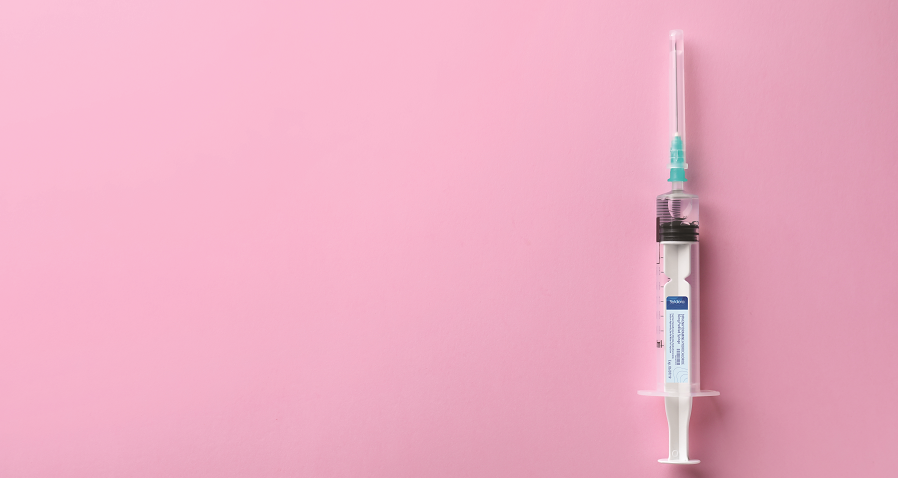Medications delivered in pre-filled syringes represent a substantial leap in the safety and accessibility of pharmaceuticals. They’re also one of the fastest-growing facets of the healthcare market. In 2018, global market revenue reached €4.4 billion, and is expected to hit €9.2 billion by 2025. According to Pharma Network Magazine, 26 percent of drugs approved in Europe between January and September of last year were delivered in an injectable device.
The spike in sales makes sense. Providing medications in prefilled, self-injectable packages improves speed of use, decreases the risk of dosing errors and drug contamination, reduces waste, and makes life easier for the growing number of people with diseases like diabetes, who administer their own medication. The emergence of biological medicines, which are especially sensitive to contamination and significantly more expensive to waste, is also driving the rise in prefilled syringes.
Choosing the right label materials for a pre-filled syringe is an important design decision.The label does more than just convey critical information. With the right materials, it can also help protect patient safety, improve speed and efficiency on the production line, and ensure regulatory compliance. At Avery Dennison, our years of experience working closely with the pharmaceutical industry has given us a front-row seat for viewing the emergence of prefilled syringes and for helping our customers (and their customers) navigate the challenges that inevitably arise. Based on what we’ve learned, here are five questions any pharmaceutical company, label converter, or packaging designer should ask when choosing label materials for a prefilled syringe:
What is the syringe made of? When you’re labeling a prefilled syringe, not just any label will do. Your label must be optimized for the syringe material itself, and for the wear and tear prefilled syringes undergo during shipment and use. Most syringes are still made of coated glass, which has high surface energy, so the label’s mandel hold tends to be better. On the other hand, the increasing numbers of syringes made of COP or COC plastic might require labels with higher initial tack and with higher adhesion properties.
Will they be safe for patients and compliant with regulations? Anyone in the pharmaceutical industry knows that going to market means meeting a crazy-quilt of safety regulations that vary by country. Be sure your label materials are properly tested and certified so that they can meet the standards for safety in every country where you sell your products. Extractables and leachables testing is especially important, to ensure that label materials don’t migrate through the container and into the medication inside. Meeting standards for cytotoxicity (ISO 10993-5 norm) is also important for prefilled syringes that are considered medical devices.
Will they support the labeling system on a high speed packaging line?
Label materials intended for use on high-speed packaging lines—those faster than 150 pieces per minute—must be robust and have high initial tack.
On these lines, labels are released from the liner and onto the substrate at very high speeds, with an application time of less than a quarter of a second. It is critical that the label material’s adhesive has a high enough initial tack to facilitate good pick-up of the label from the liner to the syringe. What’s more, the label carrier must be strong enough not to break during dispensing.
Additionally, when using UV detection systems to confirm the label presence, the label has to be luminescent. Label materials with luminescent topcoat are a good solution, thanks to the stability and durability of the luminescence they provide.
What is the temperature across the supply chain?
Supply chains have gotten more complex as medicines have become more advanced. Consider the varied temperature and humidity that the syringe will experience as it moves through the supply chain and into use. Prefilled syringes can be exposed to extremely high temperatures and humidity during autoclave sterilisation, for example, or to low temperatures when the finished product is stored or transported.
Are the label materials made nearby?
Producing prefilled syringes on multiple continents, as most drug manufacturers now do, makes it easier to meet growing global demand. But ensuring standardisation and consistent quality across all those locations can be difficult. At Avery Dennison, we’re a global company with standardized products available worldwide, enabling us to serve global customers on a local level.
Just as the right materials can improve the safety, compliance, and production of a prefilled syringe, the right partner can help you navigate the growing global pharmaceutical market and shifting regulatory landscape. Labels that met essential criteria in the recent past might already be obsolete. You’ll also want to be sure your materials have been thoroughly tested in real-world conditions and also vetted against regulations in multiple countries.



